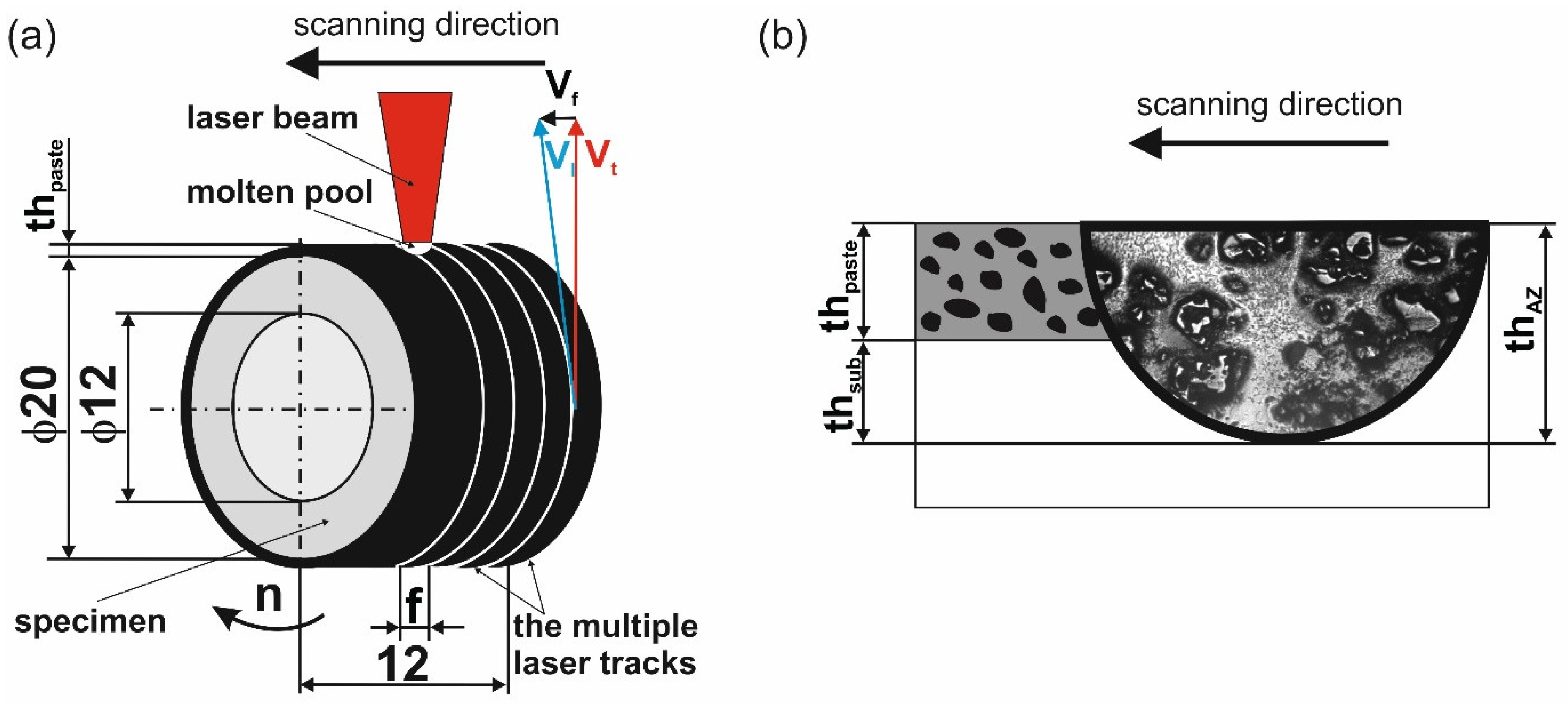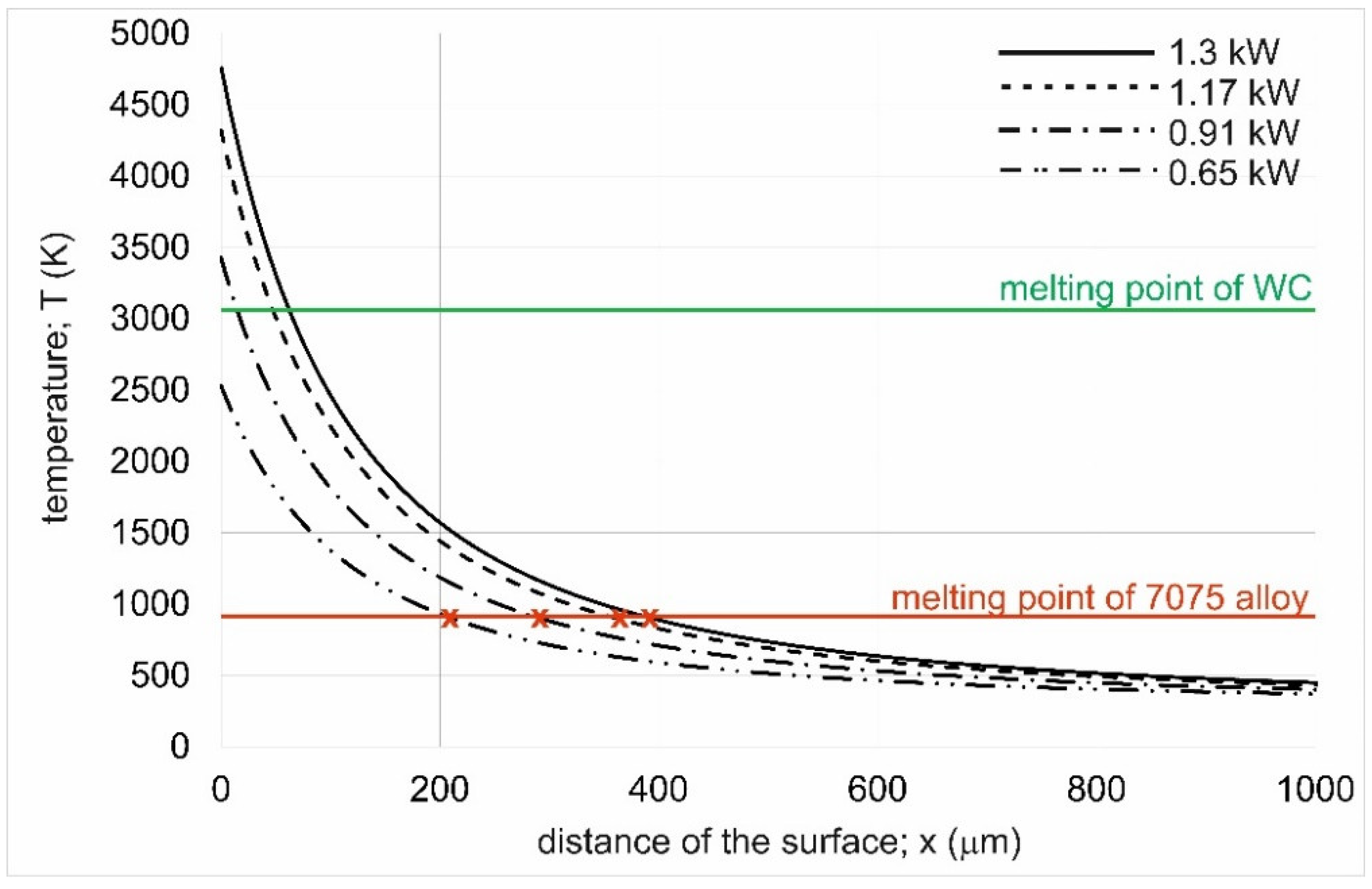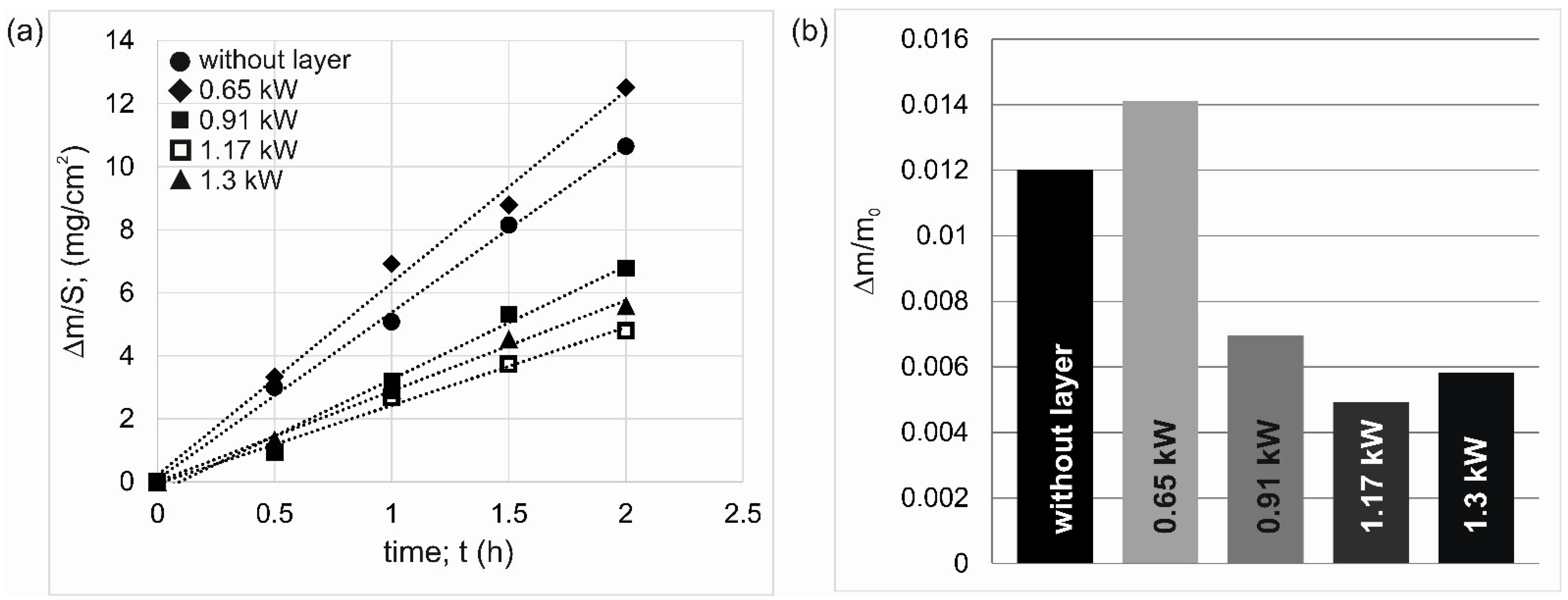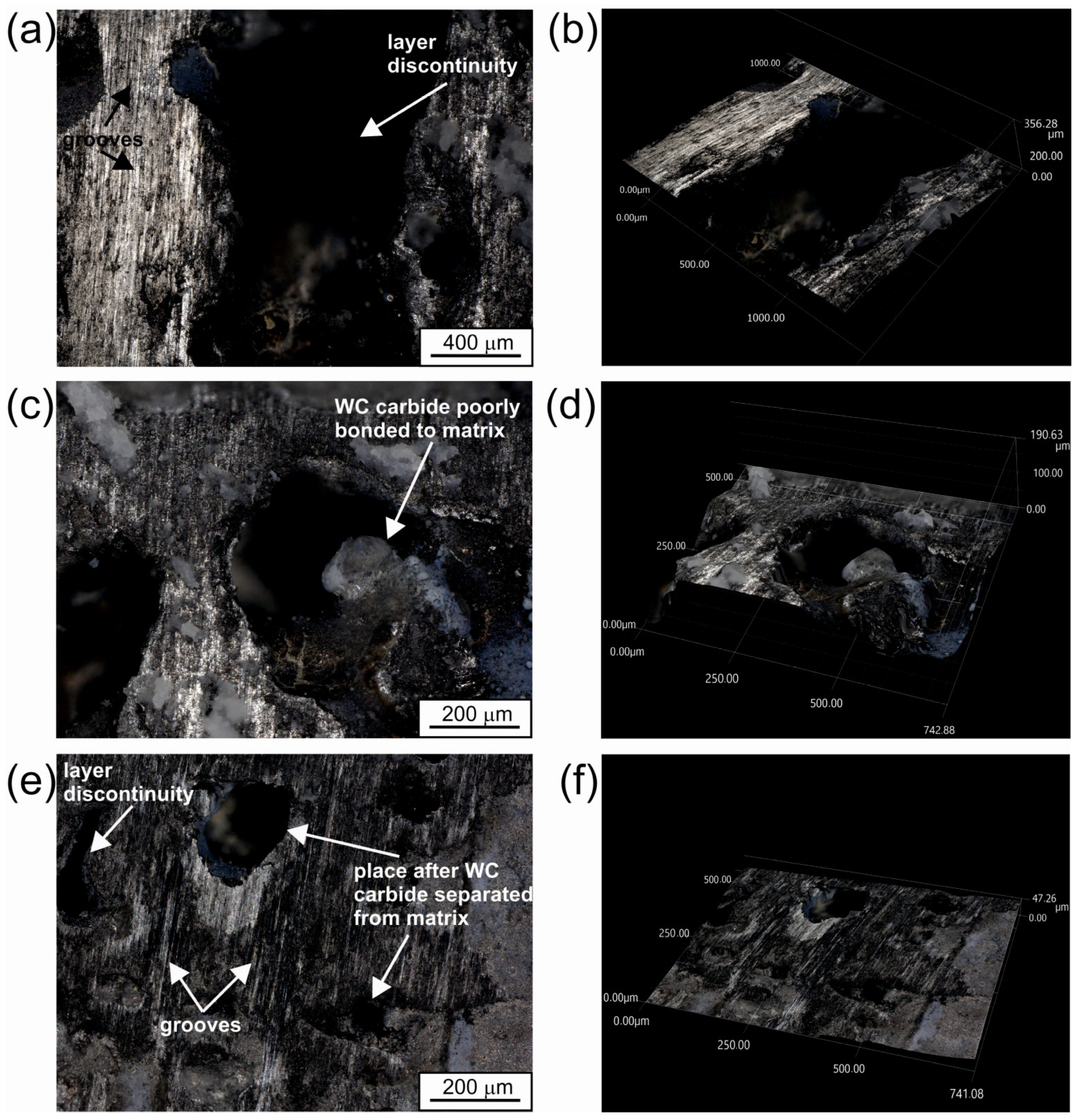The Importance of Laser Beam Power on the Microstructure and Wear Behavior of Al-WC Composite Layers Produced by Laser Surface Alloying
Abstract
1. Introduction
2. Materials and Methods
2.1. Materials
2.2. Laser Surface Alloying
2.3. Characterization of Produced WC-Al Composite Layers
2.4. Temperature Distribution Across the Axis of the Laser Track
- -
- The absorptivity of the outer surface of specimen A is a constant value and independent of temperature;
- -
- The physical properties of the alloyed and alloying materials are constant and independent of temperature.
- -
- The following assumptions were formulated with regard to process parameters:
- -
- The initial temperature T0 is equal to 293 K and is invariant during laser processing;
- -
- The laser beam moves in the x-axis direction at a constant scanning speed vl;
- -
- The thickness of the alloyed zone thAZ is defined as the intersection point of the temperature distribution profile and the melting point of the substrate material (913 K) that will be reached.
3. Results and Discussion
4. Conclusions
- (1)
- The laser beam power affected the depth of the WC-Al composite layers produced. The lowest thickness of the alloyed zone thAZ (198 µm) was measured for the layer produced with a laser beam power of 0.65 kW. Increasing the laser beam power to 1.3 kW was accompanied by a twofold increase in the average layer thickness.
- (2)
- The percentage of re-melted substrate material in the molten pool increased with increasing laser beam power.
- (3)
- The laser beam power used during surface alloying strongly affects the bond between the ceramic particles and the metal matrix. In the case of the lowest power of laser beam (0.65 kW), the temperature reached in the molten pool was too low to over-melt the edges of the reinforcing particles. As a result, there was no strong diffusion bond between the particles and the aluminum matrix.
- (4)
- In the case of the WC-Al composite layer produced at a laser beam power of 0.65 kW, its adhesion to the substrate was unsatisfactory. The layer was not well bonded to the substrate material and was characterized by high thickness inhomogeneity and high discontinuity.
- (5)
- The layer formed at the lowest laser beam power was characterized by a wear resistance lower than the 7075 alloy without a surface layer. It was caused by the insufficient adhesion of this layer to the substrate material, as well as a problem with the wettability of WC particles by liquid aluminum during the laser beam action. As a result, tungsten carbide particles were not well bonded to the metallic matrix, which caused them to peel out of the matrix during the wear test. Free WC particles were getting between the tested specimen and the counter-specimen during the wear test and working as an abrasive.
- (6)
- The layer formed using P = 1.17 kW showed the highest wear resistance. This layer showed satisfactory quality and adhesion to the substrate material.
Author Contributions
Funding
Institutional Review Board Statement
Informed Consent Statement
Data Availability Statement
Conflicts of Interest
References
- Dursun, T.; Soutis, C. Recent developments in advanced aircraft aluminum alloys. Mater. Des. 2014, 56, 862–871. [Google Scholar] [CrossRef]
- Zhu, Z.; Hu, Z.; Seet, H.L.; Liu, T.; Liao, W.; Ramamurty, U.; Nai, S.M.L. Recent progress on the additive manufacturing of aluminum alloys and aluminum matrix composites: Microstructure, properties, and applications. Int. J. Mach. Tools Manuf. 2023, 190, 104047. [Google Scholar] [CrossRef]
- Zhang, J.; Yuan, W.; Song, B.; Yin, S.; Wang, X.; Wei, Q.; Shi, Y. Towards understanding metallurgical defect formation of selective laser melted wrought aluminum alloys. Adv. Powder Mater. 2022, 1, 100035. [Google Scholar] [CrossRef]
- Yamaguchi, T.; Tanaka, K.; Hagino, H. Porosity reduction in WC-12Co laser cladding by aluminum addition. Int. J. Refract. Met. Hard Mater. 2023, 110, 106020. [Google Scholar] [CrossRef]
- Abbass, M.K. Laser surface treatment and modification of aluminum alloy matrix composites. Lasers Manuf. Mater. Process. 2018, 5, 81–94. [Google Scholar] [CrossRef]
- Zhang, H.; Ni, D.R.; Xiao, B.L.; Liu, F.C.; Ma, Z.Y. Recent progress of aluminum alloys and aluminum matrix composites produced via laser powder bed fusion: A review. J. Mater. Sci. 2024, 59, 9857–9891. [Google Scholar] [CrossRef]
- Chi, Y.; Gu, G.; Yu, H.; Chen, C. Laser surface alloying on aluminum and its alloys: A review. Opt. Lasers Eng. 2018, 100, 23–37. [Google Scholar] [CrossRef]
- Huang, K.J.; Lin, X.; Xie, C.S.; Yue, T.M. Microstructure and wear behaviour of laser-induced thermite reaction Al2O3 ceramic coatings on pure Aluminum and AA7075 Aluminum alloy. J. Wuhan Univ. Technol. Mater. Sci. Ed. 2008, 23, 89–94. [Google Scholar] [CrossRef]
- Steen, W.M.; Mazumder, J. Laser Material Processing, 4th ed.; Springer: London, UK, 2010. [Google Scholar]
- Burakowski, T.; Wierzchoń, T. Surface Engineering of Metals. Principles, Equipment, Technologies; CRC Press: Boca Raton, FL, USA, 1999. [Google Scholar]
- Almeida, A.; Anjos, M.; Vilar, R.; Li, R.; Ferreira, M.G.S.; Steen, M.W.; Watkins, K.G. Laser alloying of aluminum alloys with chromium. Surf. Coat. Technol. 1995, 70, 221–229. [Google Scholar] [CrossRef]
- Pakieła, W.; Tański, T.; Brytan, Z.; Labisz, K. The influence of laser alloying on the structure and mechanical properties of AlMg5Si2Mn surface layers. Appl. Phys. A 2016, 122, 352. [Google Scholar] [CrossRef]
- Wong, T.T.; Liang, G.Y.; Tang, C.Y. The surface character and substructure of aluminum alloys by laser-melting treatment. J. Mater. Process. Technol. 1997, 66, 172–178. [Google Scholar] [CrossRef]
- Popoola, A.P.I.; Fatoba, O.S.; Nkosi, H.W.; Aigbodion, V.S. Surface hardening of aluminum by laser alloying with molybdenum and zirconium powder. Int. J. Electrochem. Sci. 2016, 11, 126–139. [Google Scholar] [CrossRef]
- Fu, Y.; Batchelor, A.W.; Gu, Y.; Khor, K.A.; Xing, H. Laser alloying of aluminum alloy AA 6061 with Ni and Cr. Part 1. Optimization of processing parameters by X-ray imaging. Surf. Coat. Technol. 1998, 99, 287–294. [Google Scholar] [CrossRef]
- Fu, Y.; Batchelor, A.W. Laser alloying of aluminum alloy AA 6061 with Ni and Cr. Part II. The e ect of laser alloying on the fretting wear resistance. Surf. Coat. Technol. 1998, 102, 119–126. [Google Scholar] [CrossRef]
- Otani, Y.; Sasaki, S. Effects of the addition of silicon to 7075 aluminum alloy on microstructure, mechanical properties, and selective laser melting processability. Mater. Sci. Eng. A 2020, 777, 139079. [Google Scholar] [CrossRef]
- Yang, Y.S.; Bai, T.; Wang, T.; Xie, Y.W.; Chen, H.L. Properties of 6061 aluminum alloy treated with laser alloying. J. Phys. Conf. Ser. 2023, 2631, 012021. [Google Scholar] [CrossRef]
- Sroka, M.; Jonda, M.; Pakieła, W. Laser surface modification of aluminum alloy AlMg9 with B4C powder. Materials 2020, 13, 402. [Google Scholar] [CrossRef]
- Chong, P.H.; Man, H.C.; Yue, T.M. Microstructure and wear properties of laser surface-cladded MoWCMMC on AA6061 aluminum alloy. Surf. Coat. Technol. 2001, 145, 51–59. [Google Scholar] [CrossRef]
- Katipelli, L.R.; Agarwal, A.; Dahotre, N.B. Interfacial strength of laser surface engineered TiC coating on 6061 Al using four-point bend test. Mater. Sci. Eng. A 2000, 289, 34–40. [Google Scholar] [CrossRef]
- Kadolkar, P.; Dahorte, N.B. Variation of structure with input energy during laser surface engineering of ceramic coatings on aluminum alloys. Appl. Surf. Sci. 2002, 199, 222–233. [Google Scholar] [CrossRef]
- Katipelli, L.R.; Agarwal, A.; Dahotre, N.B. Laser surface engineered TiC coating on 6061 Al alloy: Microstructure and wear. Appl. Surf. Sci. 2000, 153, 65–78. [Google Scholar] [CrossRef]
- Tomida, S.; Nakata, K.; Sajic, S.; Kubo, T. Formation of metal matrix composite layer on aluminum alloy with TiC-Cu powder by laser surface alloying process. Surf. Coat. Technol. 2001, 142–144, 585–589. [Google Scholar] [CrossRef]
- Man, H.C.; Zhang, S.; Cheng, F.T.; Yue, T.M. In situ synthesis of TiC reinforced surface MMC on Al6061 by laser surface alloying. Scr. Mater. 2002, 46, 229–234. [Google Scholar] [CrossRef]
- Mabhali, L.A.B.; Sacks, N.; Pityan, S. Three body abrasion of laser surface alloyed aluminum AA1200. Wear 2012, 290–291, 1–9. [Google Scholar] [CrossRef]
- Man, H.C.; Kwok, C.T.; Yue, T.M. Cavitation erosion and corrosion behaviour of laser surface alloyed MMC of SiC and Si N on Al alloy AA6061. Surf. Coat. Technol. 2000, 132, 11–20. [Google Scholar] [CrossRef]
- Li, Y.; Zhang, P.; Bai, P.; Wu, L.; Liu, B.; Zhao, Z. Microstructure and properties of Ti/TiBCN coating on 7075 aluminum alloy by laser cladding. Surf. Coat. Technol. 2018, 334, 142–149. [Google Scholar] [CrossRef]
- Dziarski, P.; Makuch, N.; Kulka, M. The impact of laser beam power on the microstructure and some mechanical properties of laser-alloyed Inconel®600 with WC particles. Materials 2023, 16, 2619. [Google Scholar] [CrossRef]
- Ashby, M.F.; Esterling, K.E. The transformation hardening of steel surfaces by laser beams–I. Hypoeutectoid steels. Acta Metall. 1984, 32, 1935–1948. [Google Scholar] [CrossRef]
- Ion, J.C.; Esterling, K.E.; Ashby, M.F. A second report on diagrams of microstructure and hardness for heat-affected zones in welds. Acta Metall. 1984, 32, 1949–1962. [Google Scholar] [CrossRef]
- Li, W.B.; Esterling, K.E.; Ashby, M.F. The transformation hardening of steel–II. Hypereutectoid steels. Acta Metall. 1986, 34, 1533–1543. [Google Scholar] [CrossRef]
- Man, H.C.; Leong, K.H.; Ho, K.L. Process monitoring of powder pre-paste laser surface alloying. Opt. Lasers Eng. 2008, 46, 739–745. [Google Scholar] [CrossRef]
- Vora, H.D.; Rajamure, R.S.; Soundarapandian, S.; Srinivasan, S.G.; Dahotre, N.B. Dilution of molybdenum on aluminum during laser surface alloying. J. Alloys Compd. 2013, 570, 133–143. [Google Scholar] [CrossRef]
- Karantzalis, A.E.; Lekatou, A.; Georgatis, E.; Mavros, H. Solidification behaviour of ceramic particle reinforced Al-alloy matrices. J. Mater. Sci. 2010, 45, 2165–2173. [Google Scholar] [CrossRef]












| Density ρ (kg·m3) | Thermal Conductivity λ (W·m−1·K−1) | Specific Heat Cp (J·kg−1·K−1) | Thermal Diffusivity α·(m2·s−1) | Melting Point Tm (K) | |
|---|---|---|---|---|---|
| WC | 15,700 | 85.0 | 280 | 1.934 × 10−5 | 3058 |
| Al | 2700 | 237 | 897 | 9.786 × 10−5 | 933 |
| 7075 alloy | 2810 | 134 | 862 | 5.532 × 10−5 | 913 |
| 0.7 WC + 0.3 Al | 11,800 | 130.6 | 465.1 | 2.379 × 10−5 | - |
| 0.65 kW | 0.91 kW | 1.17 kW | 1.3 kW | |
|---|---|---|---|---|
| thpaste (µm) | 160 | 160 | 160 | 160 |
| thAZ (µm) | 198 | 298 | 360 | 387 |
| Percentage of substrate material in layer (%) | 19.2 | 46.3 | 55.5 | 58.7 |
| Dilution ratio DR | 80.2 | 53.7 | 44.5 | 41.3 |
| 0.65 kW | 0.91 kW | 1.17 kW | 1.3 kW | |
|---|---|---|---|---|
| Experimental thAZ (µm) | 198 | 298 | 360 | 387 |
| Theoretical thAZ (µm) | 205 | 285 | 355 | 385 |
| Without Layer | 0.65 kW | 0.91 kW | 1.17 kW | 1.3 kW | |
|---|---|---|---|---|---|
| Imw (mg/cm2/h) | 5.288 | 6.094 | 3.593 | 2.475 | 2.874 |
| Δm/m0 | 0.01201 | 0.01411 | 0.00695 | 0.00497 | 0.00583 |
| Ilw (µm/h) | - | 5.881 | 3.938 | 2.528 | 2.864 |
| ΔthAZ | - | 11.93 | 8.65 | 6.66 | 8.21 |
Disclaimer/Publisher’s Note: The statements, opinions and data contained in all publications are solely those of the individual author(s) and contributor(s) and not of MDPI and/or the editor(s). MDPI and/or the editor(s) disclaim responsibility for any injury to people or property resulting from any ideas, methods, instructions or products referred to in the content. |
© 2025 by the authors. Licensee MDPI, Basel, Switzerland. This article is an open access article distributed under the terms and conditions of the Creative Commons Attribution (CC BY) license (https://creativecommons.org/licenses/by/4.0/).
Share and Cite
Makuch, N.; Dziarski, P. The Importance of Laser Beam Power on the Microstructure and Wear Behavior of Al-WC Composite Layers Produced by Laser Surface Alloying. Materials 2025, 18, 1899. https://doi.org/10.3390/ma18091899
Makuch N, Dziarski P. The Importance of Laser Beam Power on the Microstructure and Wear Behavior of Al-WC Composite Layers Produced by Laser Surface Alloying. Materials. 2025; 18(9):1899. https://doi.org/10.3390/ma18091899
Chicago/Turabian StyleMakuch, Natalia, and Piotr Dziarski. 2025. "The Importance of Laser Beam Power on the Microstructure and Wear Behavior of Al-WC Composite Layers Produced by Laser Surface Alloying" Materials 18, no. 9: 1899. https://doi.org/10.3390/ma18091899
APA StyleMakuch, N., & Dziarski, P. (2025). The Importance of Laser Beam Power on the Microstructure and Wear Behavior of Al-WC Composite Layers Produced by Laser Surface Alloying. Materials, 18(9), 1899. https://doi.org/10.3390/ma18091899







